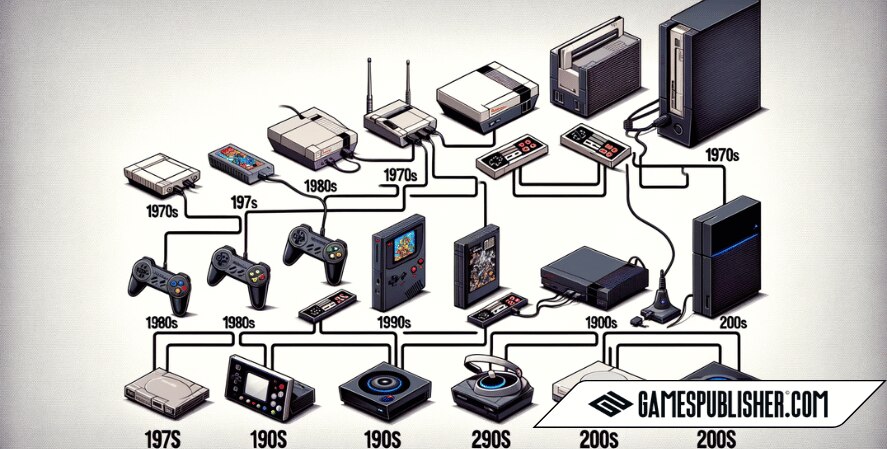The broader video gaming industry considers console games a vital component, crafting them specifically for video game consoles. Engineers specifically design these specialized electronic devices for interactive gameplay, typically connecting them to a television.
This gaming format benefits from dedicated platforms, creating distinct gaming experiences with specialized user interfaces and often exclusive content.
Definitions and Unique Characteristics of Console Gaming

Console Gaming Defined: Console gaming centers on games developed for and played on dedicated video game consoles. These devices focus exclusively on gaming, which differentiates them from PCs and smartphones.
Key Characteristics:
- Dedicated Systems: Purpose-built for gaming, consoles feature optimized hardware and software to enhance graphics and gameplay.
- Ease of Access and Setup: Consoles offer a plug-and-play experience, making gaming accessible to all ages and skill levels.
- Controller-Based Interaction: Designers primarily create games for controllers, tailoring them for ergonomic comfort and intuitive gameplay over extended periods.
- Exclusivity and Content: Developers often create games exclusively for specific consoles, fostering platform loyalty and delivering unique gaming experiences.
History of Console Gaming
Evolution from the 1970s to Present:

- 1970s: The Birth of Home Gaming
- The Magnavox Odyssey was the first commercial home video game console. It represented the initial step toward interactive gaming at home, albeit with very basic graphics and gameplay mechanics.
- The Magnavox Odyssey was the first commercial home video game console. It represented the initial step toward interactive gaming at home, albeit with very basic graphics and gameplay mechanics.
- 1980s: The Rise of Atari and Nintendo
- The Atari 2600 popularized interchangeable game cartridges and introduced the gaming joystick, a significant development in gaming interaction. Meanwhile, Nintendo’s NES (Nintendo Entertainment System) later swept the market with more sophisticated graphics and compelling games like ‘Super Mario Bros.’, setting a high standard for game design and user engagement.
- The Atari 2600 popularized interchangeable game cartridges and introduced the gaming joystick, a significant development in gaming interaction. Meanwhile, Nintendo’s NES (Nintendo Entertainment System) later swept the market with more sophisticated graphics and compelling games like ‘Super Mario Bros.’, setting a high standard for game design and user engagement.
- 1990s: The Entry of Sony and Expansion of Game Types
- Sony introduced the PlayStation in the mid-1990s, bringing significant advancements in hardware capabilities, including improved graphics and CD-ROMs. This era also saw the rise of genre-defining games like ‘Final Fantasy VII‘ and ‘Metal Gear Solid‘, which expanded the narrative and technical potential of games.
- Sony introduced the PlayStation in the mid-1990s, bringing significant advancements in hardware capabilities, including improved graphics and CD-ROMs. This era also saw the rise of genre-defining games like ‘Final Fantasy VII‘ and ‘Metal Gear Solid‘, which expanded the narrative and technical potential of games.
- 2000s to 2010s: Online Capabilities and HD Graphics
- This period marked the advent of online gaming, with Microsoft’s Xbox and Sony’s PlayStation 2 leading the way. Online multiplayer became a staple feature, fundamentally changing social interactions within games. The era also emphasized high-definition graphics, with consoles like the Xbox 360 and PlayStation 3 pushing the limits of visual fidelity.
- This period marked the advent of online gaming, with Microsoft’s Xbox and Sony’s PlayStation 2 leading the way. Online multiplayer became a staple feature, fundamentally changing social interactions within games. The era also emphasized high-definition graphics, with consoles like the Xbox 360 and PlayStation 3 pushing the limits of visual fidelity.
- 2010s to Present: Hybrid Gaming and Digital Shifts
- The introduction of the Nintendo Switch demonstrated the viability of a hybrid console capable of both home and portable play. Concurrently, the PlayStation 5 and Xbox Series X/S have emphasized not only performance but also the transition toward digital distributions and cloud gaming.
Latest Console Games and Technological Innovations

The latest console games not only reflect but also drive major advancements in technology and game design. These developments have transformed how players experience games and significantly impacted both gamers and developers.
Technological Breakthroughs:
- Advanced Graphics and Realism: The latest games, like ‘God of War Ragnarok’ and ‘Elden Ring’, utilize the enhanced capabilities of new consoles such as the PlayStation 5 and Xbox Series X/S to deliver ultra-realistic graphics and smooth performance. These games feature detailed environments, realistic lighting, and animations that significantly enhance immersion.
- Faster Load Times and Enhanced Performance: With the integration of solid-state drives (SSDs) in new consoles, games now benefit from dramatically reduced load times and more seamless gameplay experiences. This technology allows for larger, more complex worlds with fewer interruptions.
- Ray Tracing Technology: Ray tracing, now supported by new gaming consoles, adds realistic lighting effects that mimic the way light interacts with objects in the real world, greatly improving visual fidelity and realism.
VR and AR Gaming:

- Mainstreaming of VR: The PlayStation VR2 and other console-compatible VR devices have brought virtual reality into more common use, offering games that are completely immersive. Developers expect to adapt games like ‘Half-Life: Alyx’ for PlayStation VR2, positioning them to set new standards for VR in terms of interaction and environmental manipulation.
- Innovative AR Applications: Augmented reality in gaming is still developing but offers a unique blend of real-world and enhanced visuals. AR features in console games can transform ordinary living spaces into interactive game environments, expanding the possibilities for gameplay in everyday settings.
Narrative Depth and Diversity:
- Complex Storytelling: Games like ‘The Last of Us Part II’ are at the forefront of narrative complexity in console games, offering deep, multi-layered stories that engage players emotionally. Advanced motion capture techniques and voice acting support these narratives, bringing characters to life in unprecedented ways.
- Diverse Perspectives and Inclusive Content: The industry is seeing a trend toward including more diverse characters and storylines that represent a wide array of backgrounds and experiences. Games like ‘Marvel’s Spider-Man: Miles Morales’ highlight cultural diversity and receive praise for their authentic representation and relatable narratives.
- Interactive Story Elements: Many modern games incorporate choices that affect the story’s outcome, providing a personalized story experience. Titles like ‘Detroit: Become Human’ effectively implement this by blending narrative depth with player decision-making.
Current Trends in Console Gaming

- Online Services and Subscription Models: Services such as Xbox Game Pass and PlayStation Now provide players with a library of games available for a monthly fee, reflecting a shift towards service-based consumption.
- Environmental Considerations: Console manufacturers are increasingly considering the environmental impact of their products, with initiatives aimed at reducing carbon footprints and improving energy efficiency.
- Indie and Diverse Game Development: There’s a significant move towards supporting indie developers and games that offer diverse perspectives and experiences, enriching the gaming landscape and appealing to a broader audience.
Conclusion
The journey of console gaming from the simplistic Magnavox Odyssey to today’s sophisticated systems illustrates a dynamic evolution driven by technological innovation and changing consumer demands.
As the industry continues to advance, console gaming remains at the forefront of delivering engaging, immersive, and diverse entertainment experiences.

